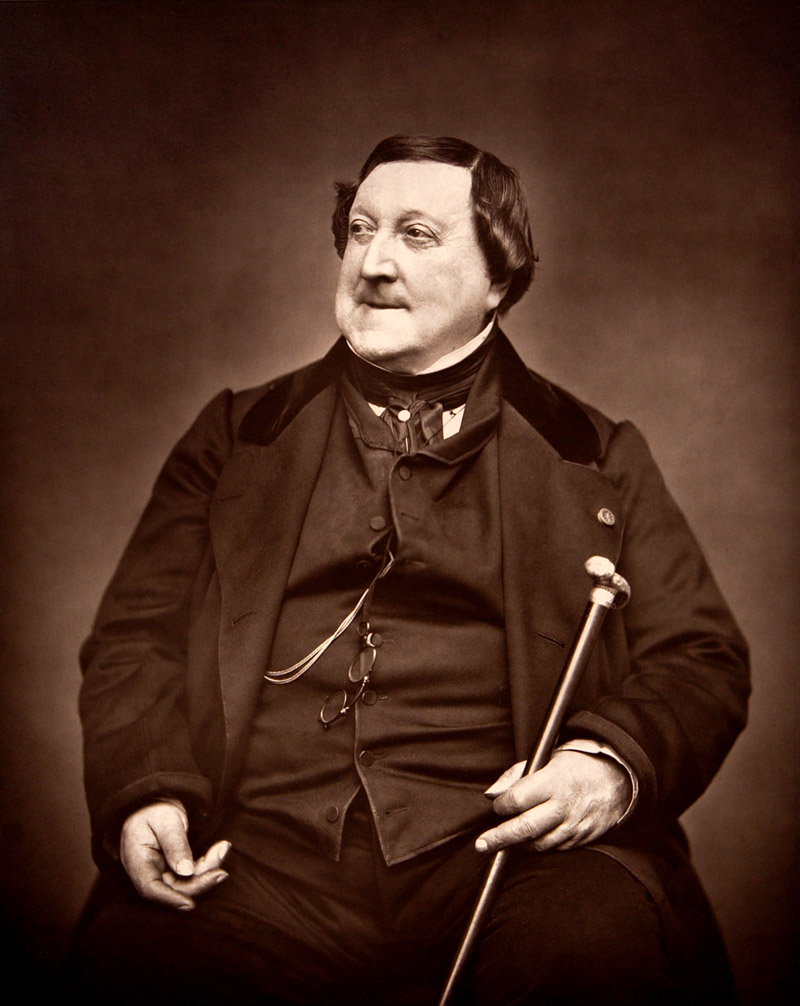Perhaps you’ve remembered that 31st March is the birthday of Johann Sebastian Bach, considered by many musicians to be one of the greatest composers who ever walked the earth, if not the greatest. It is also the birthday of another “great”, the Austrian composer Joseph Haydn, who revolutionized symphonic music in the eighteenth century and became known as The Father of the Symphony. He was also known as The Father of the String Quartet which in Haydn’s hands became virtually full-length symphonies for four instruments. So it seemed appropriate that this week’s column should honour Bach and Haydn. But then I thought, why should I? They never did anything for me.

So instead, I shall tell you about two well-known pieces of music which in their different ways have close connections with American popular culture of the 1950s, though neither composer could possibly have envisioned what those connections would be.
Gioachino Rossini was the most popular opera composer in history. He wrote his first opera at the age of eighteen and then went on to churn out a staggering list of works which are still popular today such as The Barber of Seville, The Italian Girl in Algiers, and The Thieving Magpie. Many of Rossini’s overtures have become popular as stand-alone concert pieces.
In 1829, after composing thirty-nine major operas Rossini retired. It would seem that he’d simply had enough. And in any case, he had become extremely wealthy. In the remaining forty years of his life he wrote a few choral and vocal works but continued to indulge in his life-long passion for cooking and eating, much to the detriment of his waistline.
Written in 1829, William Tell was Rossini’s last opera and was based on a play of the same name by Friedrich Schiller. This in turn was based on the fourteenth century Swiss legend about the freedom-fighter and mountain climber William Tell who was also an expert shot with the crossbow. He, you will recall was the folk hero who, as a punishment for not bowing to authority was required to shoot an apple placed on his son’s head. The story is closely linked to the Swiss struggle for independence from the Habsburg Empire. Unusually the overture was written in four distinct movements played without a break.
I had completely forgotten the delightful opening prelude (entitled Dawn), scored for five cellos accompanied by basses and interrupted ominously by distant rolls of thunder. Musical raindrops lead into a whirling storm for the full orchestra in which the trombones play a dramatic role. The storm fades into a charming pastoral movement (Call to the Cows) featuring a cor anglais solo and gorgeous woodwind writing.
The finale is often known as March of the Swiss Soldiers. After some lively trumpet fanfares the music becomes an energetic march – played at an indecently furious tempo in this recording. If you’re over A Certain Age, you’ll probably associate this music with the 1950s TV series The Lone Ranger about the masked do-gooder who, with the help of his ever-present chum Tonto fought outlaws and other undesirables in the American Old West. The Russian composer Dmitri Shostakovich jokingly quoted the same melody in the first movement of his Fifteenth Symphony.
When Emmanuel Chabrier and his wife toured Spain in 1882, Chabrier was an amateur composer, a lawyer by training who worked as a civil servant. The tour marked a huge change in his musical fortunes. Chabrier was enthralled with everything he saw and heard and felt that “an extraordinary fantasia” of wonderful music would emerge from his experiences. España was first performed in Paris in 1883 and was an immediate success. It made the composer an overnight celebrity and it was reported that some of the tunes were being whistled on the streets of Paris.
The overture opens quietly with a rhythm in triple time suggesting the strumming of a guitar. Suddenly, it’s echoed by the full orchestra and a joyful second theme is heard on the French horns. Chabrier used dramatic light and shade throughout the work especially in the middle section with its atmospheric use of repeated chords on the harp. At the time, the music must have sounded distinctly modern.
Chabrier’s colourful melodies must have proved too much of a temptation for the American song writers Al Hoffman and Dick Manning who in 1956 stole the tunes and simplified them for a song poetically entitled Hot Diggity. It was recorded by Perry Como and like Chabrier’s original composition was an instant success. I’d guess that the tune of Hot Diggity was soon being whistled on the streets of New York.
 |
 |
 |





